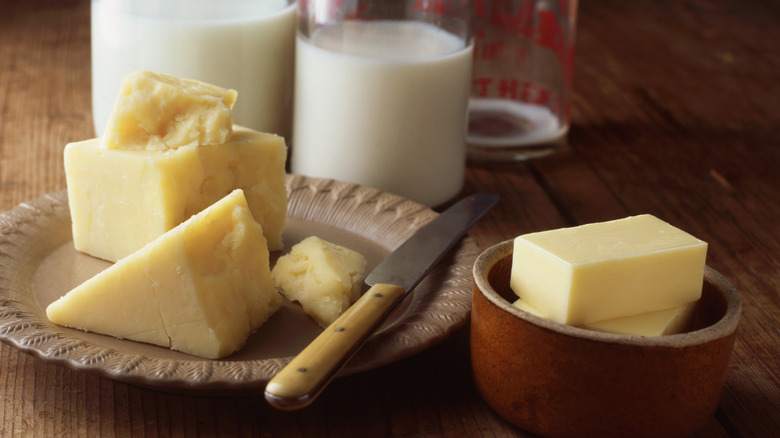Keep That Leftover Block Of Cheese Fresh With A Stick Of Butter
While plenty of cheeses benefit from a bit of aging, that doesn't mean you can leave the cut edge of yours open to the air of your fridge. Oxidation and fungal spores may ruin its flavor, drying it out or developing some unsightly mold. Luckily, you probably already have the solution on hand: butter.
Much like the creative uses for leftover butter wrappers, the stick itself can be used outside of cooking. By smearing a square of room temperature butter over the cut edge of cheese, you're essentially sealing the vulnerable portion off from the air. Remember, butter is usually about 80% fat, so it has a similar effect to coating a pan with oil to prevent oxidation (rust). Butter is especially great for this since it's also a dairy product, and its natural flavors won't overtly interfere with the taste of most cheeses.
You'll still need to seal your cheese in wax paper, a zip-top bag, or an airtight container to maximize its shelf life, but this simple trick is both easy and delicious. After all, who doesn't love a bit of butter with certain cheeses? While it may not be useful for crumbled cheese like feta or exceptionally soft varieties with no rind like goat cheese, there are plenty of common types that can benefit from a smear of preserving butter.
What cheeses can you use the butter trick on?
To keep cheeses moist and delicious, it mostly comes down to storing them in a temperature- and humidity-stable part of your fridge. However, with the butter trick, even cheese stored in the worst part of your fridge may be able to retain its flavor and texture.
For the best results possible, use the butter trick on firm to hard cheeses. These typically have low moisture content already and can't afford to lose anymore. While a high-moisture cheese like soft goat will likely spoil from mold before oxidation, hard and semi-hard cheeses like cheddar or parmesan are especially prone to drying out. These types of cheese don't always require refrigeration, so if you opt out of keeping them cold, this is also a great way to protect them from mold spores.
Only use this trick on cheese you don't mind tasting a bit buttery. While it may be tempting to use this on an expensive block of specialty cheese, you probably shouldn't. Many cheeses like to breathe meaning they have live elements to them that take on the flavor of their surroundings. Typically, cheesemongers recommend sealing them in specialty cheese paper to avoid contaminating their flavor. Were you to seal their cut edges with butter, you run the risk of them taking on too much buttery taste, ruining their natural flavors.


